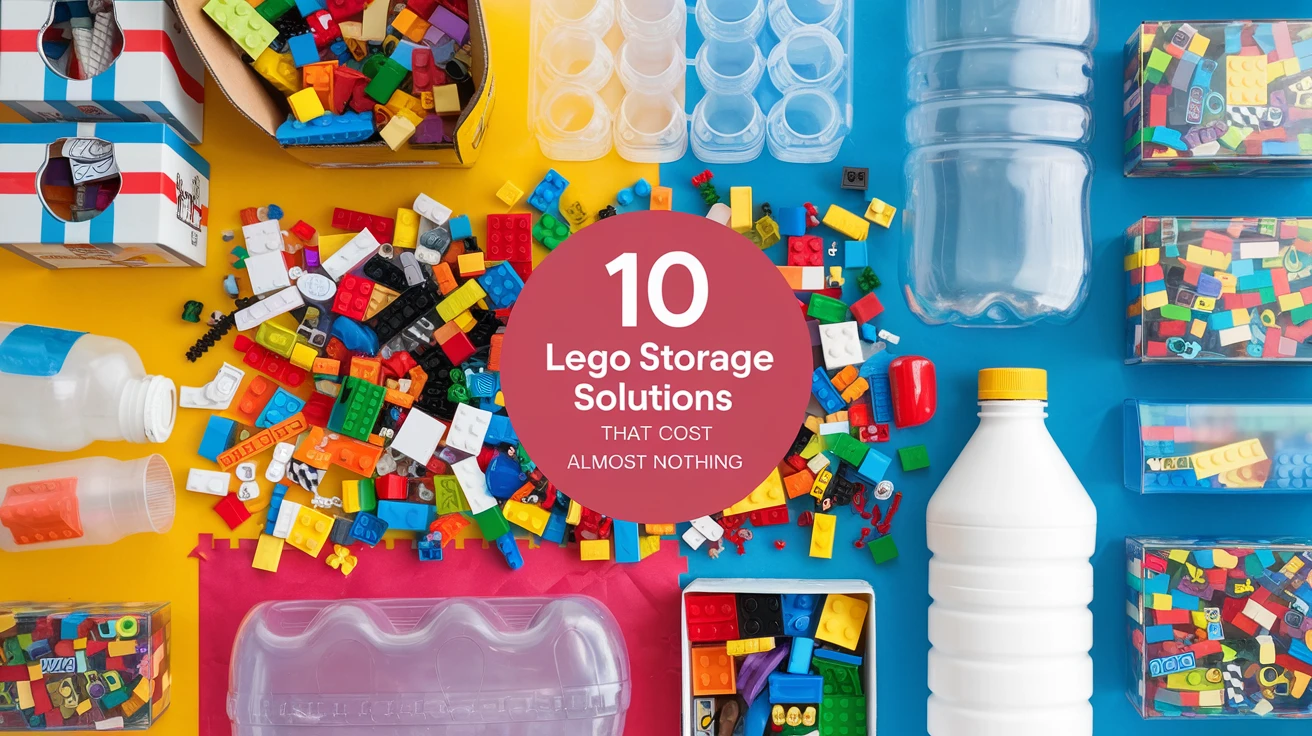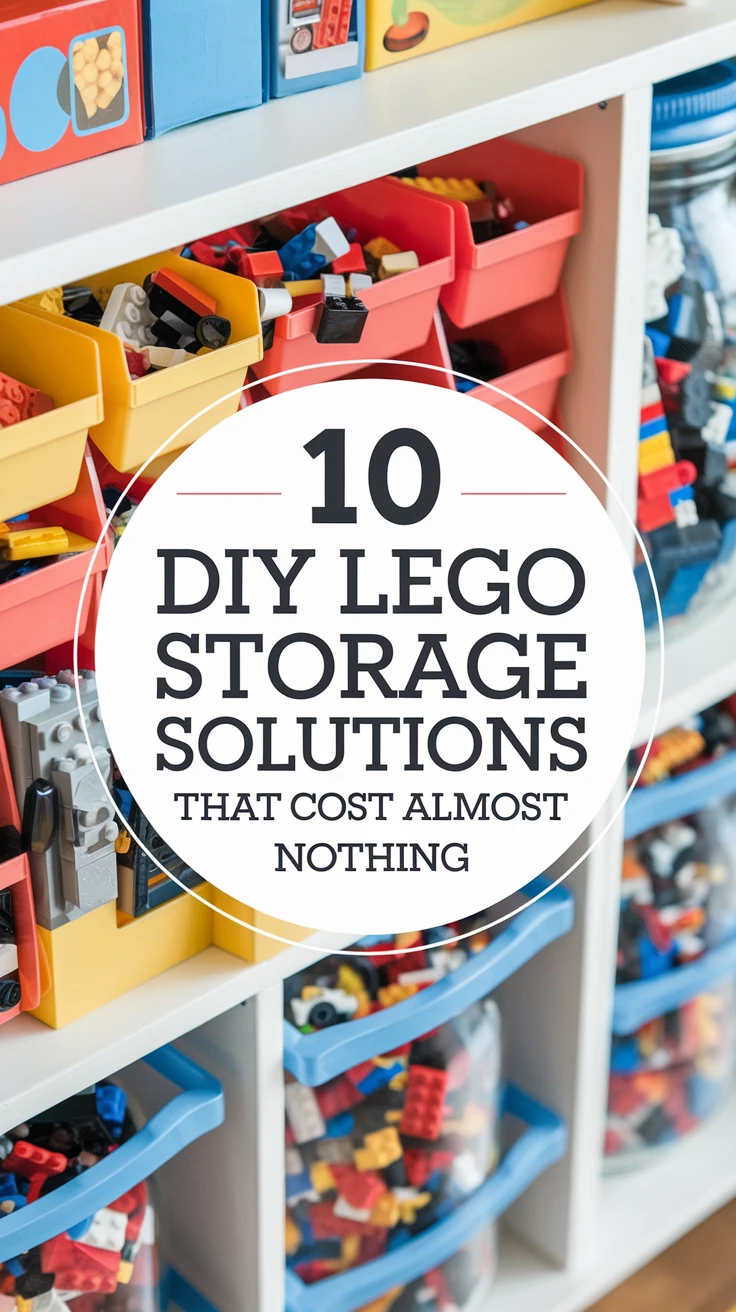
As a parent and LEGO enthusiast, I’ve learned the hard way (literally, by stepping on countless bricks) that proper LEGO storage isn’t just a luxury—it’s a necessity. But here’s the thing: those fancy storage solutions at the store can cost a small fortune. After years of trial and error, I’ve discovered some incredibly effective DIY LEGO storage solutions that cost next to nothing. These aren’t just theoretical ideas; they’re battle-tested solutions that have saved both my feet and my wallet. Whether you’re dealing with a small collection or thousands of pieces, these budget-friendly storage hacks will help you organize your LEGO bricks without breaking the bank.
1. Shoe Box Sorting System
Remember those shoe boxes you were about to throw away? Hold onto them! They make perfect LEGO storage containers. I’ve transformed over a dozen shoe boxes into an efficient sorting system, and the total cost was exactly zero dollars. Here’s how to create your own:
– Cut cardboard dividers to create compartments
– Cover boxes with decorative paper (optional)
– Label each section clearly
– Stack boxes efficiently
The best part? You can customize the compartment sizes based on your specific needs. I’ve found that standard shoe boxes work perfectly for basic bricks, while smaller boxes (like those for kids’ shoes) are ideal for tiny pieces.
| Box Type | Best For | Number of Compartments |
|---|---|---|
| Adult Shoe Box | Basic bricks, larger pieces | 4-6 |
| Kids’ Shoe Box | Small pieces, minifigures | 8-10 |
| Boot Box | Sets, instruction manuals | 2-3 |
2. Clear Plastic Bottle Storage
Those empty 2-liter soda bottles aren’t trash—they’re treasure! After thoroughly cleaning and drying them, these transparent containers become perfect storage solutions for smaller LEGO pieces. Here’s what I’ve learned works best:
– Remove labels using warm water and soap
– Cut the top off cleanly (about 2 inches below the neck)
– Sand any sharp edges
– Add a decorative tape border for safety and style
Pro tip: The clear walls make it super easy for kids to spot exactly what they need. I’ve lined up six bottles on my son’s shelf, each containing different colored pieces, and it’s made cleanup time so much more manageable.
3. Hanging Fabric Organizer
Got an old over-the-door shoe organizer? This might be my favorite hack yet. Each pocket is perfect for different LEGO categories, and it takes up zero floor space. Here’s how to optimize it:
| Pocket Position | Suggested Contents | Access Level |
|---|---|---|
| Top Rows | Rarely used pieces | Adult height |
| Middle Rows | Frequently used bricks | Kid height |
| Bottom Rows | Current projects | Easy access |
The fabric pockets are surprisingly durable, and the whole system can hold hundreds of pieces while keeping them dust-free.
4. Cardboard Box Drawer System
Using old shipping or moving boxes, I’ve created a modular drawer system that rivals expensive furniture solutions. Here’s my step-by-step process:
– Cut boxes to uniform sizes
– Reinforce corners with duct tape
– Create pull handles using rope or spare cardboard
– Label clearly with pictures for younger builders
The beauty of this system is its scalability—you can add or remove boxes as your collection grows or shrinks.
5. Ice Cube Tray Small Parts Storage
Don’t toss those old ice cube trays! They’re perfect for sorting tiny LEGO pieces like gems, small accessories, and special pieces. I’ve found that stacking multiple trays works brilliantly:
– Clean thoroughly and dry completely
– Label each compartment
– Stack and secure with rubber bands
– Store in a drawer or on a shelf
This method has saved countless minutes of searching for those tiny, essential pieces.
6. DIY LEGO Table from Old Coffee Table
Transform an unwanted coffee table into a LEGO building station. While this might sound ambitious, it’s surprisingly simple:
– Clean the table surface thoroughly
– Attach LEGO base plates using strong adhesive
– Add storage solutions underneath
– Consider adding wheels for mobility
The cost? Just some adhesive if you have an old table available. The value? Priceless for keeping LEGO play contained and organized.
7. Mason Jar Collection Display
Those spare mason jars in your kitchen can become beautiful LEGO displays. I’ve used this method for special collections and it looks fantastic:
– Clean jars thoroughly
– Add labels or tags
– Group similar pieces together
– Stack safely on shelves
Pro tip: Use larger jars for basic bricks and smaller ones for special pieces or completed mini-builds.
8. Cereal Box Sorting Stations
Before recycling those cereal boxes, consider turning them into sorting stations. Here’s how:
– Cut at an angle for easy access
– Reinforce with clear packing tape
– Label clearly
– Arrange in a row or stack
These make perfect temporary sorting solutions during big builds or cleaning sessions.
9. Under-Bed Rolling Storage
That space under the bed is prime LEGO storage real estate! Create rolling storage units using:
– Flat cardboard boxes
– Old skateboard wheels or furniture casters
– Dividers from recyclable materials
– Clear plastic wrap for dust protection
This solution has saved valuable floor space in my kids’ room while keeping LEGOs easily accessible.
10. Wall-Mounted Display from Food Containers
Clean plastic food containers can become wall-mounted storage and display units:
– Thoroughly clean containers
– Create mounting brackets from strong cardboard
– Secure safely to wall
– Label fronts clearly
The vertical storage saves floor space while keeping pieces visible and accessible.
Conclusion
After implementing these storage solutions, I’ve saved hundreds of dollars compared to store-bought options, and my LEGO organization is better than ever. The key is to start with what you have and get creative. Remember, the perfect storage solution is the one that works for your space, your collection, and your building style. Don’t be afraid to mix and match these ideas to create your own custom system.
Key Takeaways
- Most effective LEGO storage solutions can be created from items you already have at home
- Proper labeling and categorization are crucial for any storage system
- Consider accessibility and ease of cleanup when choosing storage solutions
- Vertical storage options can maximize space efficiency
- Regular maintenance and reorganization keep any system working effectively
Frequently Asked Questions
-
How should I sort my LEGOs when starting from scratch?
Start by sorting by color or size, whichever makes more sense for your building style. For smaller collections, color sorting usually works best. For larger collections, consider sorting by piece type first, then color within each type.
-
What’s the best way to clean containers before using them for LEGO storage?
Wash thoroughly with warm, soapy water, rinse well, and dry completely. For plastic containers, ensure all food residue is removed. Allow 24-48 hours of drying time to prevent any moisture issues.
-
How can I make sure my DIY storage solutions are child-friendly?
Round off any sharp edges, ensure containers are sturdy enough not to tip over, and place frequently used pieces at child height. Always secure wall-mounted solutions properly.
-
What’s the best way to label storage containers?
Use a combination of words and pictures, especially if young children will be using them. Clear, large labels work best, and consider using color-coding for easier identification.
-
How often should I reorganize my LEGO storage system?
Review and adjust your system every 3-4 months, or whenever you notice pieces frequently ending up in the wrong places. This helps maintain organization and lets you adapt to changing needs.
-
Can I mix different storage solutions?
Absolutely! In fact, using a combination of storage methods often works better than sticking to just one. Different pieces and sets may require different storage approaches.
-
What should I do with LEGO instruction manuals?
Store them in clear sheet protectors in a three-ring binder, or dedicate a specific container that keeps them flat and protected from damage.
-
How can I prevent LEGOs from getting dusty in open storage?
Use containers with lids when possible, or cover open containers with clear plastic wrap. Regular cleaning with a small brush or compressed air can help maintain pieces.
-
What’s the best way to store LEGO sets that are currently being built?
Use shallow containers or trays that can slide under furniture when not in use. This keeps pieces together while protecting them from dust and loss.
-
How can I maintain my DIY storage solutions long-term?
Regularly check for wear and tear, reinforce weak points with tape or glue, and replace containers that show signs of breaking down. Clean containers periodically to prevent dust buildup.
